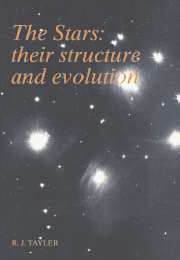Book contents
- Frontmatter
- Contents
- Preface
- Symbols
- Numerical values
- 1 Introduction
- 2 Observational properties of stars
- 3 The equations of stellar structure
- 4 The physics of stellar interiors
- 5 The structure of main sequence stars and pre-main-sequence evolution
- 6 Early post-main-sequence evolution and the ages of star clusters
- 7 Mass loss from stars
- 8 Close binary stars
- 9 Advanced evolutionary phases
- 10 The final stages of stellar evolution: white dwarfs, brown dwarfs, neutron stars and black holes
- 11 Concluding remarks
- Appendix 1 Thermodynamic equilibrium
- Appendix 2 The equation of radiative transfer
- Appendix 3 The pressure of a degenerate gas
- Suggestions for further reading
- Index
Preface
Published online by Cambridge University Press: 05 June 2012
- Frontmatter
- Contents
- Preface
- Symbols
- Numerical values
- 1 Introduction
- 2 Observational properties of stars
- 3 The equations of stellar structure
- 4 The physics of stellar interiors
- 5 The structure of main sequence stars and pre-main-sequence evolution
- 6 Early post-main-sequence evolution and the ages of star clusters
- 7 Mass loss from stars
- 8 Close binary stars
- 9 Advanced evolutionary phases
- 10 The final stages of stellar evolution: white dwarfs, brown dwarfs, neutron stars and black holes
- 11 Concluding remarks
- Appendix 1 Thermodynamic equilibrium
- Appendix 2 The equation of radiative transfer
- Appendix 3 The pressure of a degenerate gas
- Suggestions for further reading
- Index
Summary
This book is in effect a second edition of a book first published by Wykeham Publications in 1970. The Wykeham series was designed to bridge the gap between school and university science and the mathematical level of the book was designed to be suitable for sixth formers. In fact the main use of the book has been as a university textbook and some of the mathematics which was then taught in schools is now taught at university. In rewriting the book, I have not changed its general level, but I have introduced two appendices containing more mathematical detail relating to topics discussed in the main text.
Many branches of physics such as gravitation, thermodyamics, atomic physics and nuclear physics are combined in determining the structure of stars. As a result the subject provides an ideal example of the application of fundamental physics. Physical conditions in stars are more extreme than on Earth and a successful understanding of their structure should show how valid it is to extrapolate established physical laws to these conditions. Although it is profitable to study stars as isolated objects, an understanding of star formation and stellar evolution is central to the whole study of astronomy.
Significant progress has been made in explaining the observed properties of stars but there is still room for considerable improvement in the relation between theory and observation. In particular the process of star formation is not well understood theoretically or observationally. In fundamental physics there is still need for a reliable theory of fully developed convection.
- Type
- Chapter
- Information
- The StarsTheir Structure and Evolution, pp. ix - xPublisher: Cambridge University PressPrint publication year: 1994



